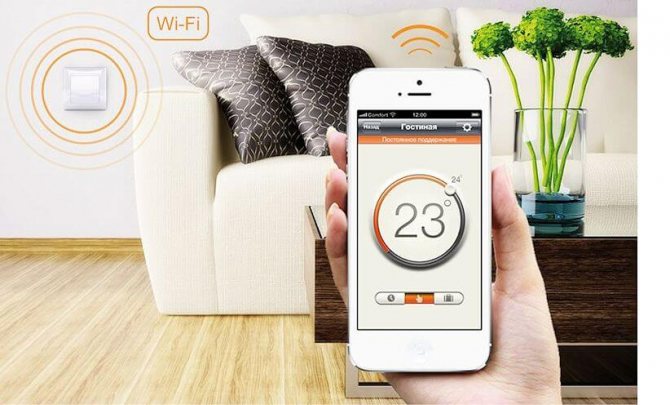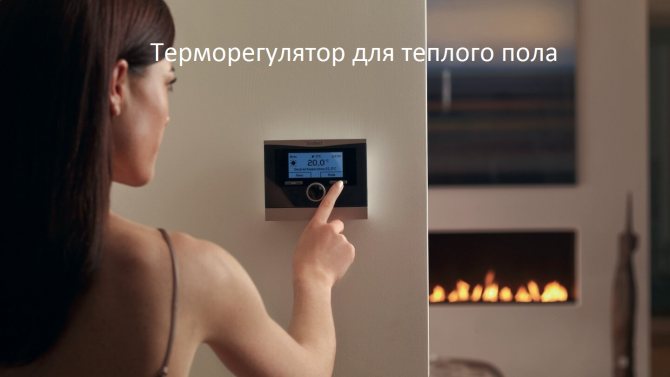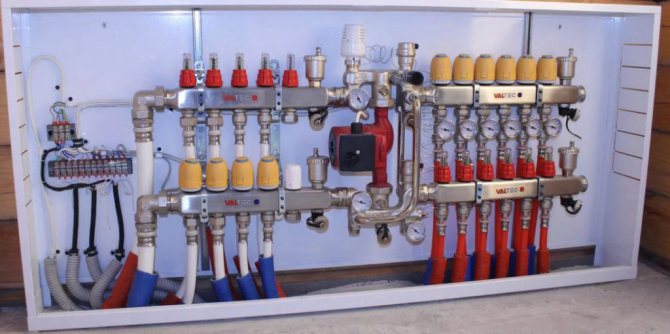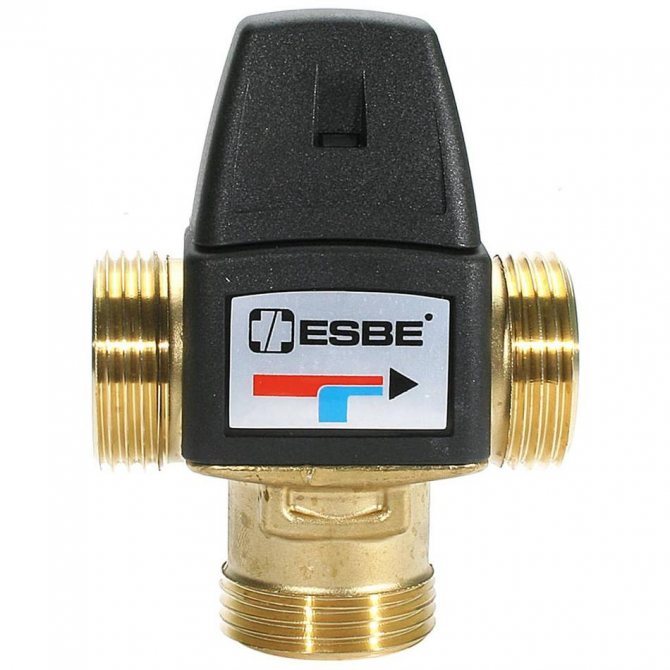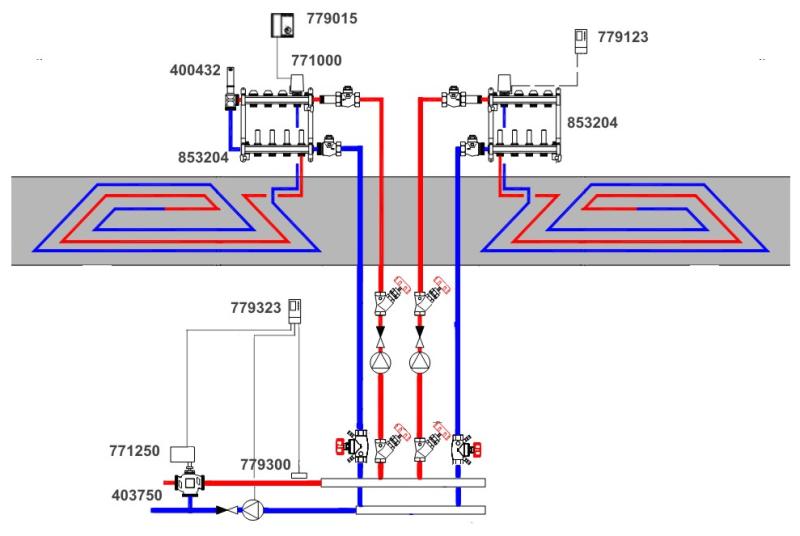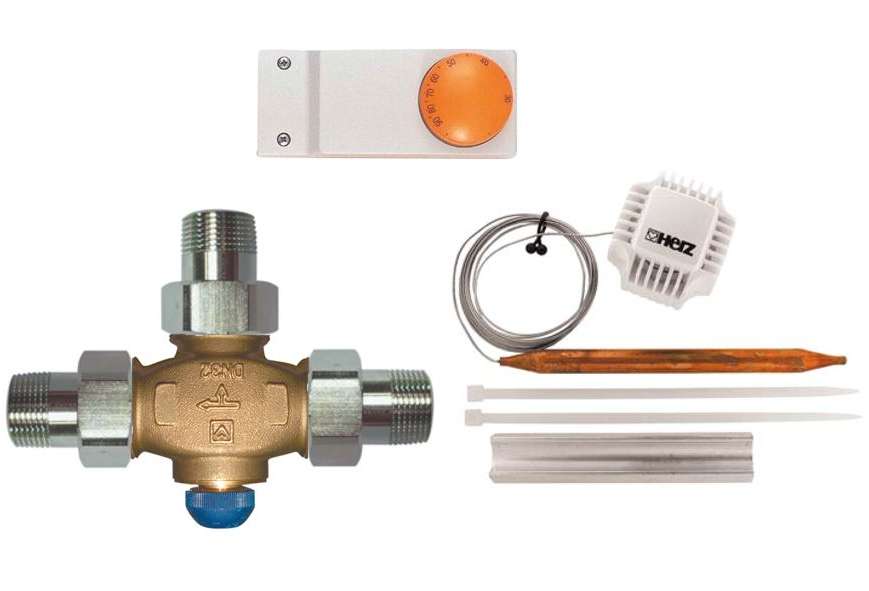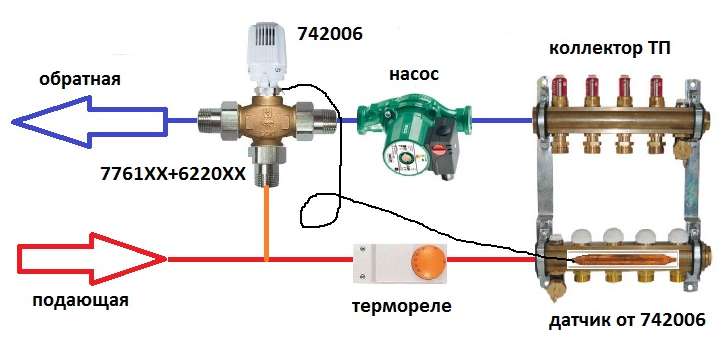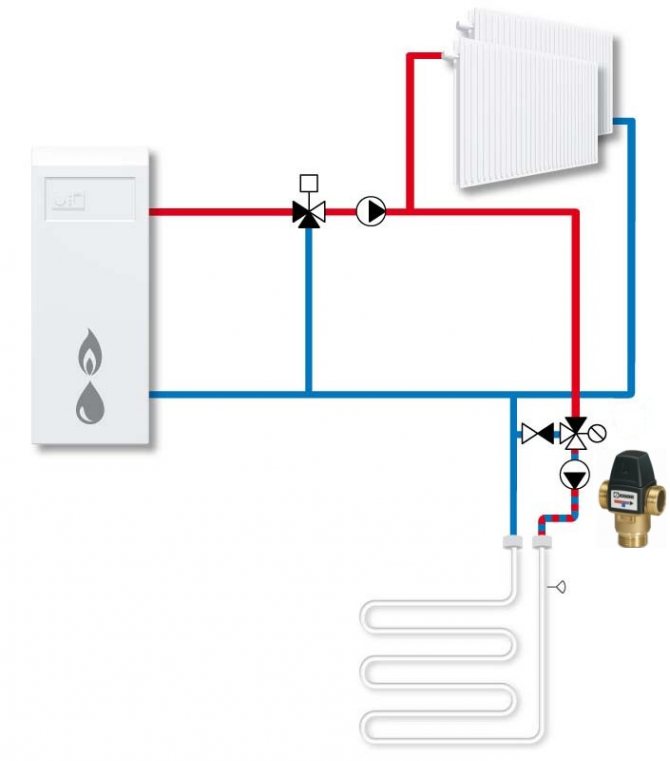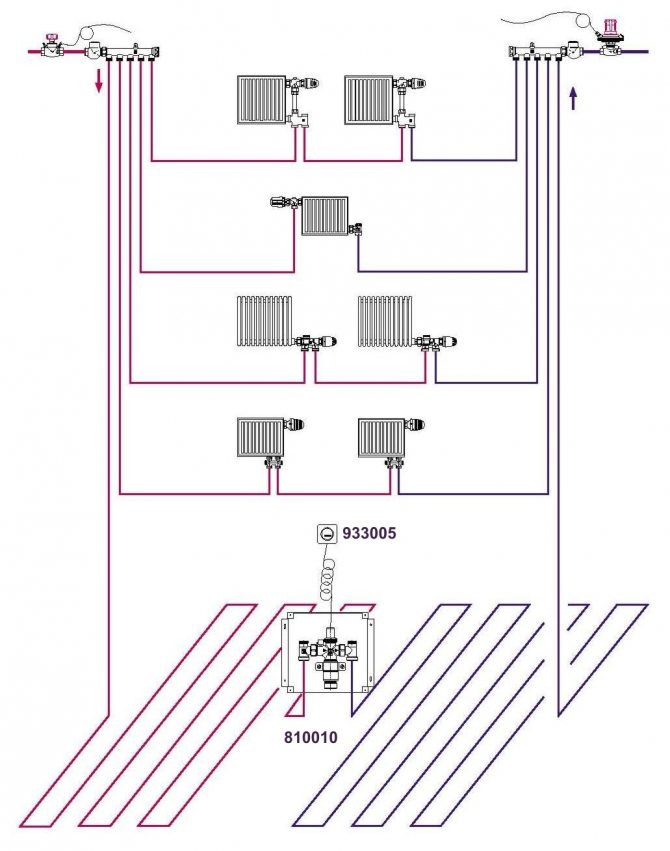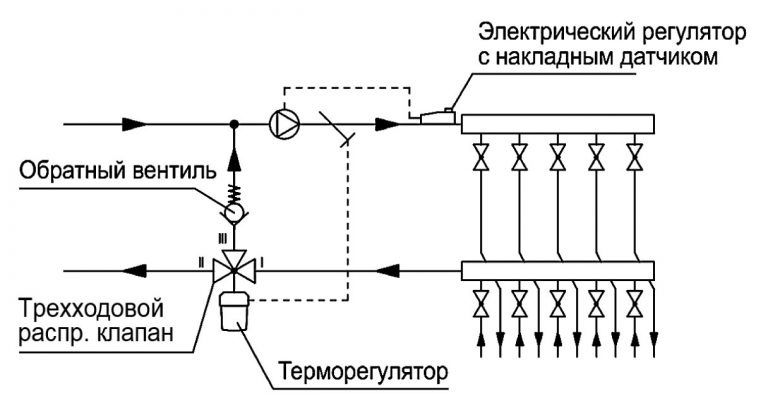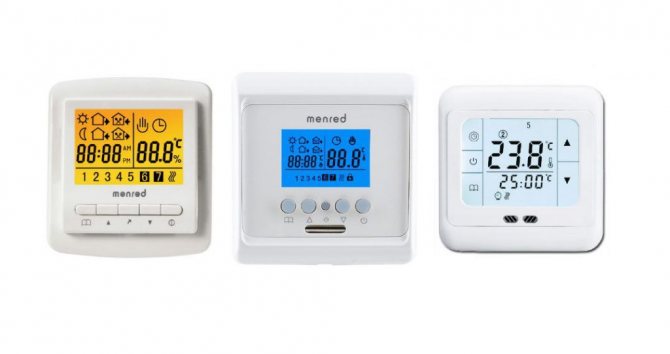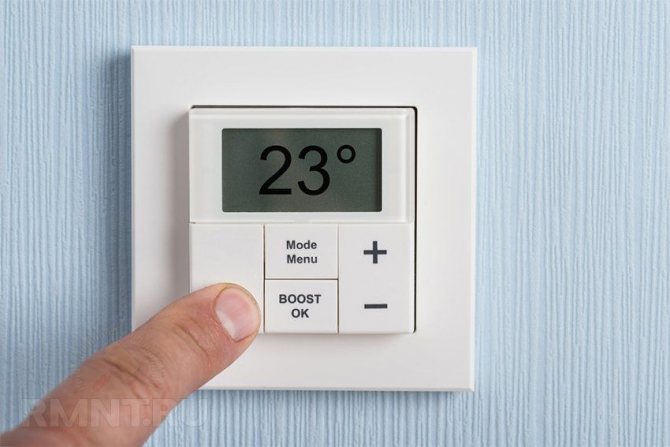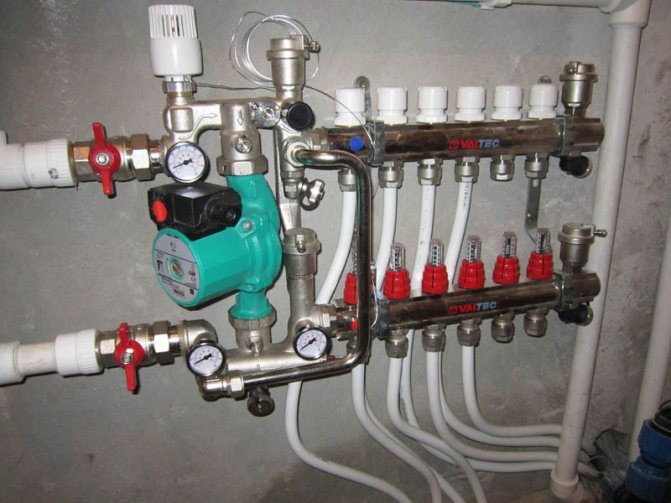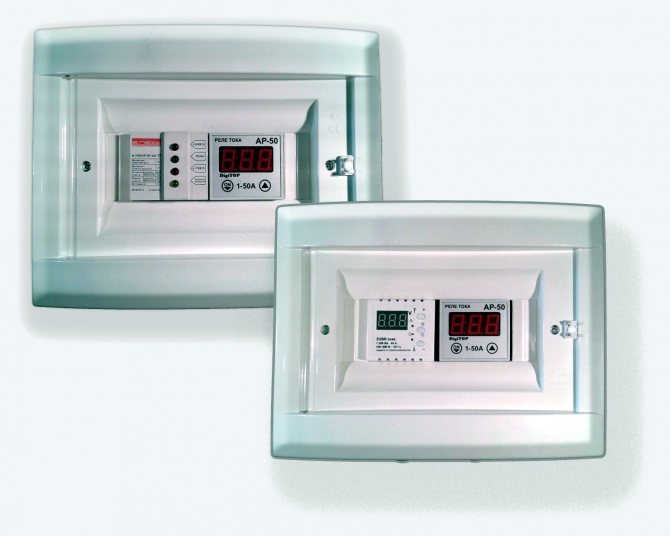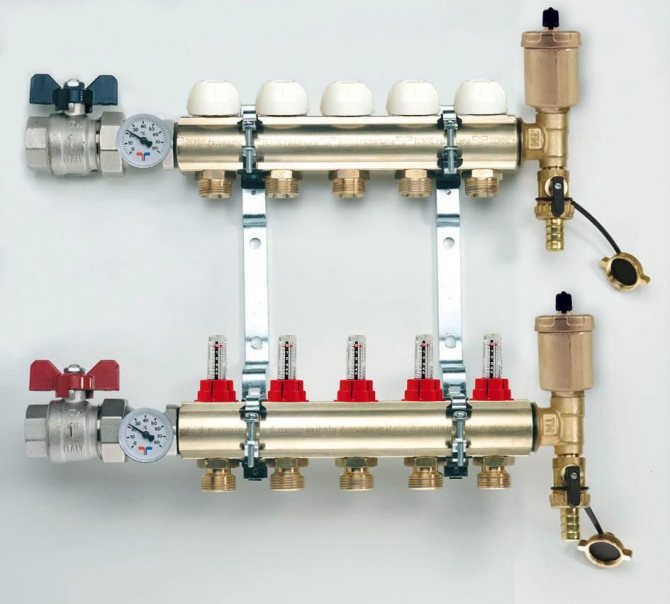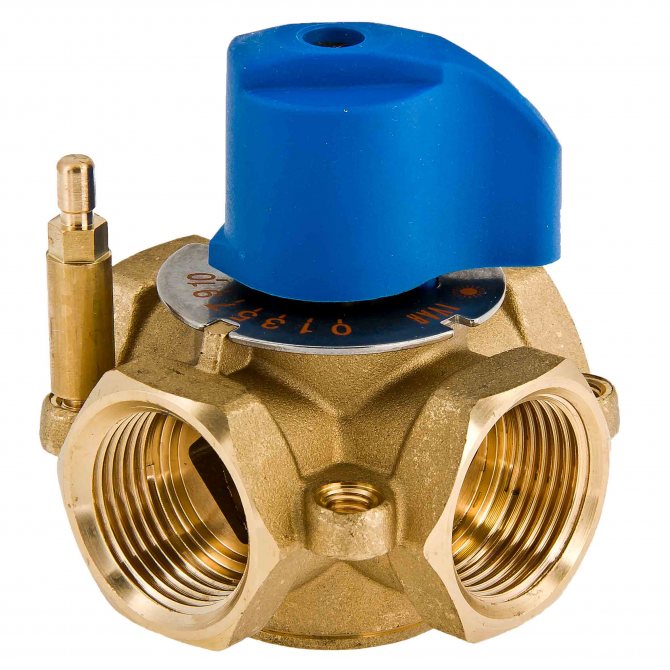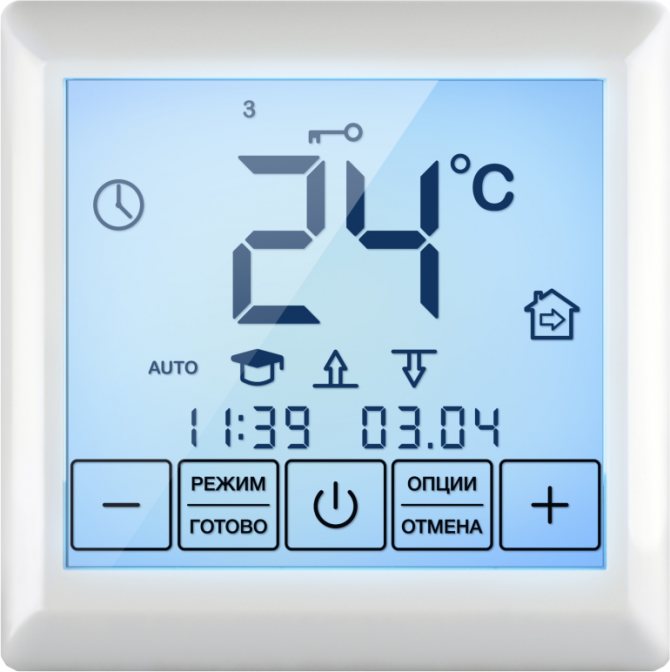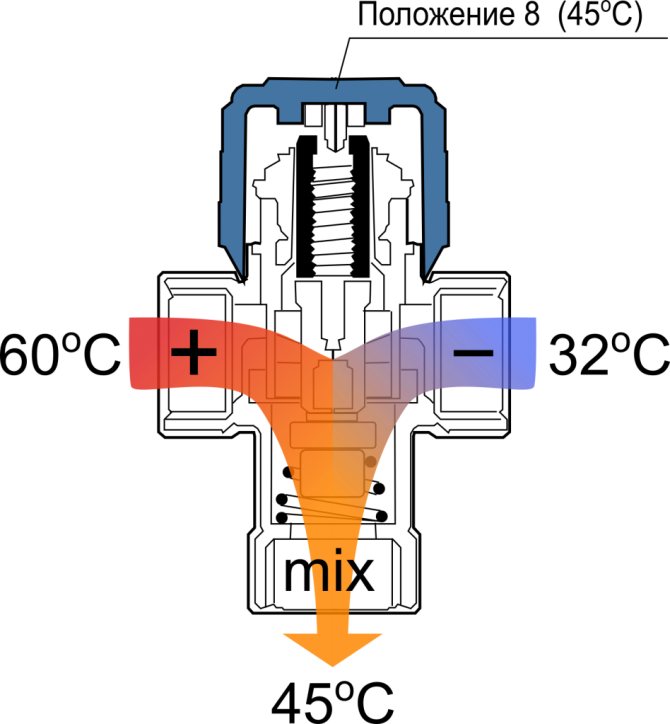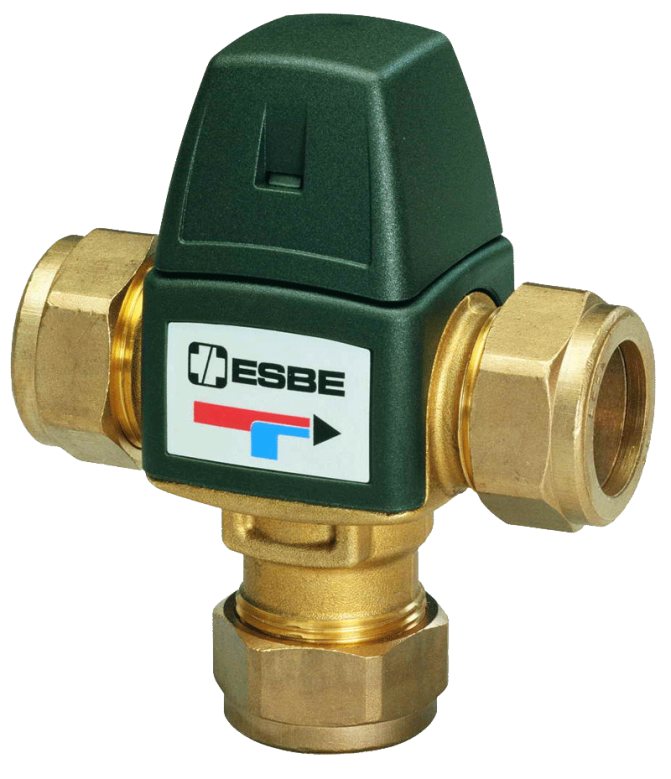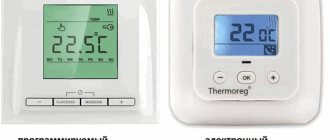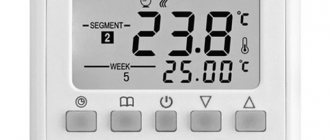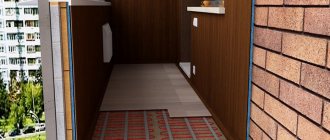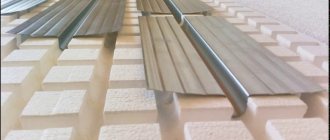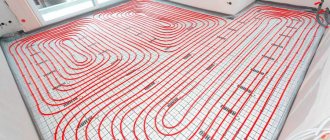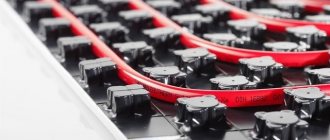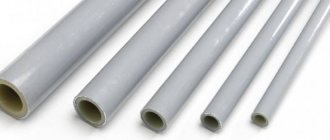To control the water underfloor heating, a room thermostat is installed in each room, which controls the corresponding electric motorized directional head on the underfloor heating collector.
If all directions of the underfloor heating are closed, then the pump will be protected from working in a closed tap by the presence of a bypass bypass on the mixing unit - the pump will simply run idle.
It would seem that this is enough.
But in order to exclude the idle operation of the pump of the mixing unit, an additional device is required. This device will also help to turn off the heating boiler when the temperature set by the thermostats is reached in all rooms.
In order not to suddenly reinvent the bicycle, as he once tried to invent a collector for underfloor heating, let's study what kind of central control devices for underfloor heating are already on sale.
Looking ahead, I will say that I chose Beok CCT-10 to solve this problem, which I described in a separate article: Testing the Beok CCT-10 underfloor heating controller.
A central control unit for underfloor heating is required, which, based on the signals received from the thermostats, will start the boiler and the pump of the mixing unit.
The operation algorithm of the central device is very simple: addition according to the OR scheme of signals from room thermostats and output of the resulting signal to the pump and boiler.
It turned out that I was not the only one who had such a problem and there are industrial-scale devices for its solution.
Heating zone controller COMPUTHERM Q4Z.
COMPUTHERM Q4Z on the manufacturer's website.
There is a wireless analogue.

This is a wonderful device and it implements even more than I could think of: three, summarizing different zones, outputs and the ability to manually control zones.
Such a controller would suit me if not for one thing.
Any room thermostat can be connected to the zone controller. So it is written in the passport and it can be understood that the thermostat must have normally open contacts.
It so happened historically, but most of the thermostats I have turned out to be more suitable for controlling an electric underfloor heating. They issue a control signal in the form of 220V.
Here is a classic connection diagram for thermostats for underfloor heating:


This signal, in addition to controlling the heater, can be used to control a pump or motorized heads. It is no longer possible to use this device for logical operations with received signals of this kind.
I don't understand why this is done and why not just bring out the relay contacts - this would be a universal way. Although, on the other hand, installation is more convenient without unnecessary jumpers in the installation box - the incoming 220V wire and the outgoing wire to the warm floor sit on the corresponding terminals without additional connections. Two additional contacts on the thermostat would help here so that you can remove or put a jumper.
There is one more factor - the price in Russia, which is 8000r. How does the price of UAH 1547 in Ukraine turn into the price of RUB 8000 in Russia?
But I would find someone to bring him from Barabashovo, if I needed him.
It will not work for me, since it only requires relay contacts.
Floor heating mode
The mode is selected at the discretion of the residents. The most common is comfort or heating. In the first variant, the surface temperature is maintained at the level of 28-320C. Here the function of heating the main room is performed by other devices, such as radiators.The second option provides for maintaining the set air temperature in the room, which should provide a warm floor. For this, room thermostats are used to control the heating.
How much liquid passes through the circuit is shown by a rotameter installed on the supply manifold. The thermal head for a water underfloor heating is installed on the return manifold.
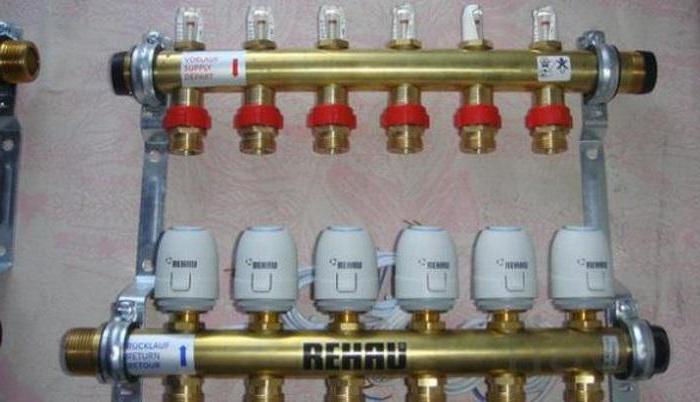

The pressure in the system is created by the central circulation pump of the heating boiler. In order for him to be able to push through all the loops, the length of each should be no more than 60 m.
Controller for control of a water heat-insulated floor Tech L-5.
The Tech L-5 is a very interesting instrument.
It costs 5238r.
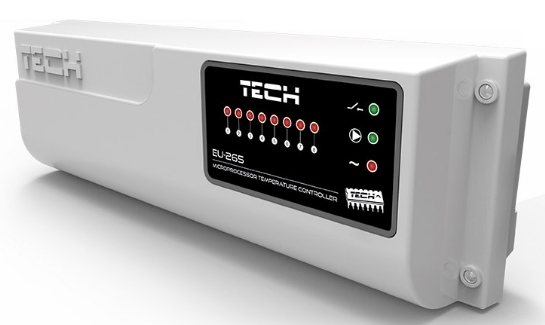

Designed to control thermostatic valve actuators using wiring, to collect and process information received from system components, as well as to transmit control commands to them.
This is the simplest model with reduced functionality and there are more complex devices: with radio thermostats, WiFi, cloud service and off we go.
Allows you to control the temperature in eight different heating zones.
Possibility to control 22 thermostatic actuators with 8 room regulators:
- 3 room regulators make it possible to service up to 12 servos;
- 5 room regulators make it possible to operate up to 10 servos.
One 230V output per pump.
Dry contact output for control of an additional heating device.


The price of 5-6 thousand for such a device does not seem large.
Here are just the input signals for this controller must also be relay contacts.
Nice. The connection terminals are hidden. It will not work for me, since it only requires relay contacts. Very sorry.
High-quality control of the temperature of the warm floor
The method consists in mixing hot water coming from the boiler with the cooled coolant returning back to heating. For this, a three-way valve with a thermal head for underfloor heating is used. As a result, water is supplied to the heating system at a predetermined temperature.
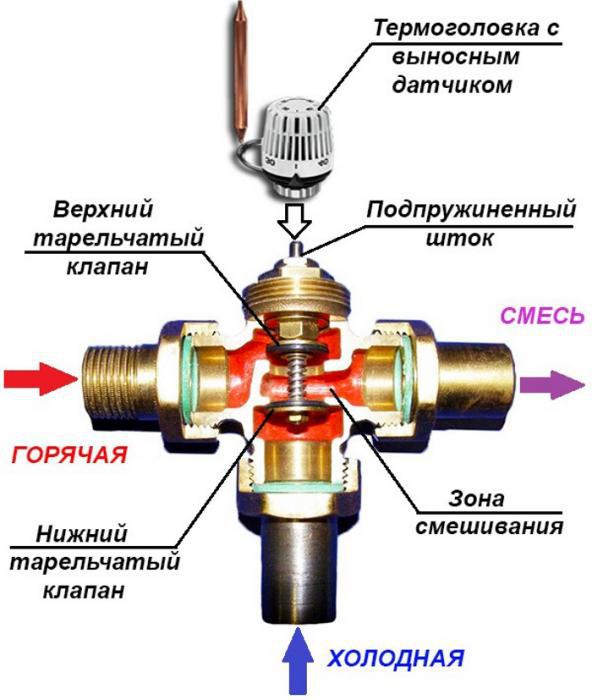

The thermal head is connected to the valve stem through the axle box, which locks the entrance to the place of its connection. On a signal from a temperature sensor, the stem with two poppet valves moves. In this case, the passage for one flow opens, and closes for the other, as a result of which the temperature of the coolant supplied to the heating circuit changes.
Salus KL06 wired switching center.
Salus KL06 in the store.
Costs 4281r.
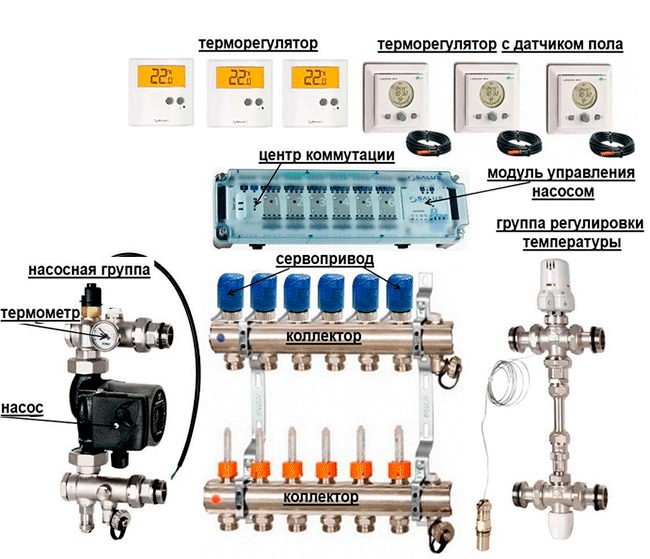

The KL06 controller is designed to connect thermostats and actuators into a single switching unit. There is an indication of the status of the servos.
Pump and boiler control is possible only after connecting additional modules Salus PL06 or PL07 (1700r and 2800r).
If you carefully read the instructions of the Salus KL06, you can find out that this is a more cunning device than it might seem.
Works fully with Salus thermostats.
+ Show quotes from this passport with a description of the functions.
PWM, VP, NSB SYSTEMS
The systems used in the Salus ERT series thermostats provide more efficient underfloor heating control.
PWM.
Due to the large inertia of the floor heating, the use of the PWM system in the ERT series controllers guarantees us a precise maintenance of a constant temperature in the premises. The PWM system monitors the working hours as well as the opening and closing frequency of the used servomotors in relation to the rise in room temperature. The result is additional savings, comfort, and the absence of overheating of the room.
VP.
It is a system that protects and lengthens the life of the servomotors. Opens and closes the servomotor once a week, even if the system is not currently operating (time outside the heating season).
NSB.
Temperature reduction function - NSB (Night Set Back).The system provides the ability to influence the temperature depending on the time of day, which guarantees efficient control of the heating system. The temperature reduction function makes it possible to reduce it by 4 ° C, without thermostat regulation, even with the use of non-programmable regulators in most zones.
The NSB function in the regulators is activated by an external signal transmitted to the Salus KL06 bar using the Salus ERT50 weekly thermostat. This regulator must be connected to the field marked with number 1.
All controllers must be connected using a 4-core wire, according to diagram number 1.
If you do not connect the field indicated by the clock, the MSB function will not be active, but the rest of the controller functions (PWM and VP) will work.
These are the diagrams for connecting thermostats.
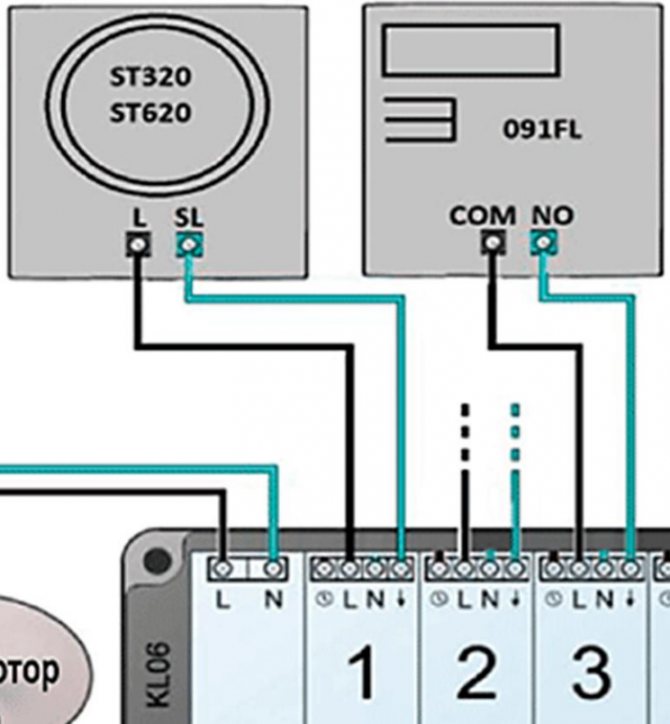

The connection diagram of the ST320 thermostat is unusual - let's see what is in the passport of this thermostat.


It seems that the thermostat controls exactly 220V, passing or not passing through itself. If so, the Salus KL06 controller may be suitable for working with thermostats that issue 220V for load control.
I don't like it visually, and with a pump and boiler connection module it costs more than 6000r and has open terminals. I will not have Salus thermostats, so smart functions are not available.
Return temperature limiter
The regulator Unibox Rtl Oventrop, which limits the degree of heating of the return flow, is used on small underfloor heating areas <20 m2. The range of the normalized temperature is 20-50 ° C and depends on the indicator set by the thermal head, due to which the degree of permissible heating is maintained automatically.


Regulator for underfloor heating Unibox Rtl Oventrop
A similar scheme involves the installation of the Unibox Rtl Oventrop so that the coolant circulates through the entire underfloor heating circuit and only then through the Rtl controller.
The principle of its operation differs from the functioning of the mixing unit, where, in order to achieve the required temperature, liquid flows are mixed with different degrees of heating, controlled by a valve.
When using the Rtl regulator, no mixing occurs when water enters the underfloor heating loops, that is, when connected to a radiator heating, the coolant immediately moves into the heating pipeline. The task of the RTL valve built into the regulator is to limit the temperature of the liquid flow already at the outlet of the pipes of the water circuit, in accordance with the standard established.
Such a piping assumes the supply of hot coolant in portions, so that overheating does not occur. The inertial screed also helps smooth out the temperature.
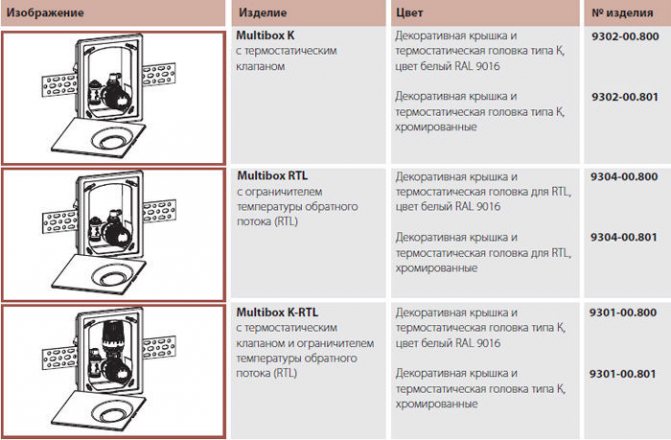

Dimensions of Rtl valves
When equipping a water heating circuit system with an Rtl valve, it should be taken into account that the temperature set on the backflow liquid flow limiter should not be lower than the room air values.
If this requirement is not met, then an unstable incorrect functioning of the Rtl regulator may occur.
Structurally, it consists of a body, a stem travel limiter, and a liquid sensor, thanks to which data on the temperature of the passing stream is transmitted to maintain the set heating value in automatic mode.
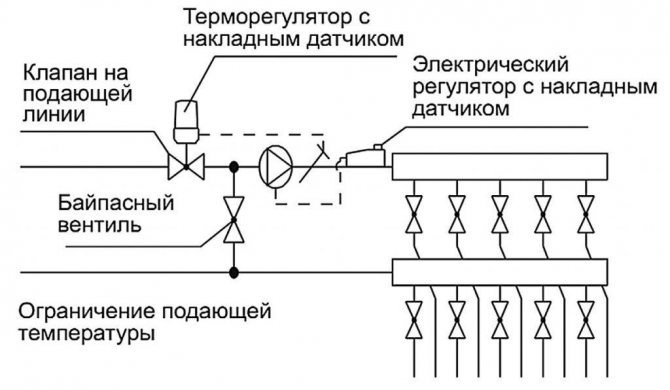

Water underfloor heating control circuit
The Rtl valve opens only if the maximum value has not been reached. A similar regulator is also used when equipping a warm water circuit of a combined type, when the coolant flows in parallel to the radiators and to the system.
A variety of options for connecting a water heating circuit allows you to rationally decide which circuit will be suitable for specific conditions.In country houses, when installing a local boiler with a controlled temperature of the outgoing water flow, it is possible to directly connect without additional nodes designed to reduce the degree of heating of the coolant.
Control module Watts WFHC-BAS.
Watts WFHC-BAS 6 zones, 220V, normally closed servos costs 5650r.
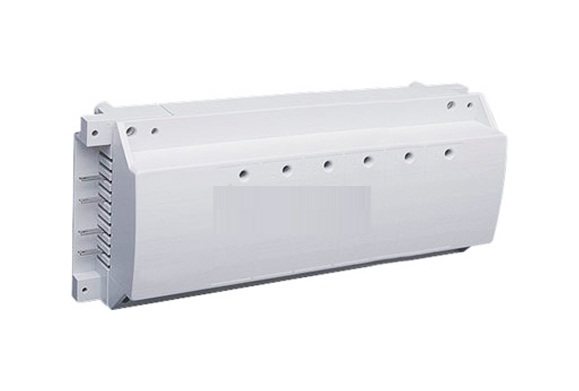

Watts WFHC-BAS passport.
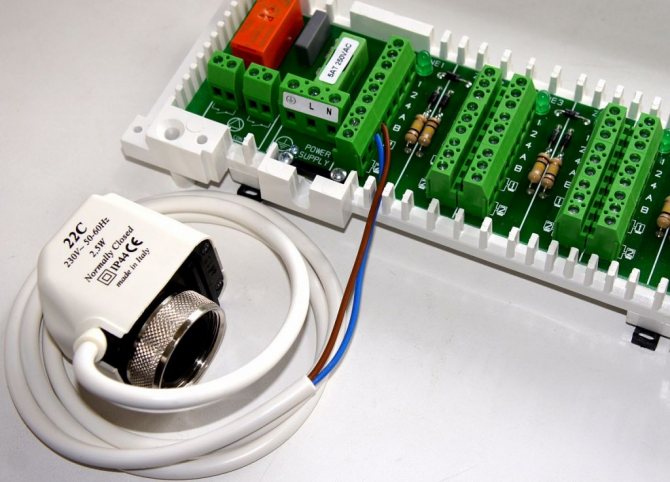

The module can be used as an independent device and as a component of an automation system. There are options for expanding and using radio modules.
If you use a module with a programming function and native thermostats, you can program all thermostats from one module.
Consider the connection diagrams from this passport.


It looks like this is exactly what I need. It is possible to connect 220V thermostats! In addition, the connection terminals are hidden and from the photo you can see that it is a quality product.
Servos for manifold
For underfloor heating, the pipeline is connected to a manifold. The equipment has outlets for hot coolant and for chilled liquid that is pumped into the boiler. The number of outlets in the manifold corresponds to the number of water heating circuits. A coolant of a certain temperature is supplied to the line. Servos are designed to regulate it by means of valves located on the manifold.
Recommended: How to install Q-Term underfloor heating?
The underfloor heating control unit has the following components:
- spring made of nichrome; an electric current passes through it;
- container with thermal fluid; it is heated by means of a nichrome spring;
- the stem to which the cold circuit valves are attached;
- thermal sensor; the device is installed on the underfloor heating liquid circuit;
- thermostat; it is programmed for a certain mode; a temperature sensor and a servo cable are connected to it.
A certain heating mode is set on the thermostat. If the floor temperature exceeds the set parameter, the thermostat closes the servo circuit. The spring, which is in the thermal fluid, begins to heat up.
The fluid expands and presses on the stem, which opens the valve for the cold circuit. In the mixing chamber, the hot coolant and the chilled water are mixed. Warm liquid enters the floor line.
When the set temperature drops, the thermostat opens the servo circuit. The spring begins to cool down, the thermal fluid cools down and narrows. The stem rises and closes the cold circuit outlet. The underfloor heating system is installed in Moscow for heating country cottages.
When using a servo drive, the thermal fluid heats up and cools down quickly. The system changes the operating mode in 1-3 minutes. The thermal head on the mixing unit turns off the heating system for 15 minutes. The machine for the warm floor can be controlled remotely by means of servo drives using electronic gadgets.
Heat controller Teplocom TC-8Z.
I found this device in an unexpected place - from the manufacturer Bastion, who is known for backup power supplies for signaling.
Costs 3900r - the recommended price on the manufacturer's website.
It costs 3600r.


Passport teplocom-tz-8z.pdf.
We find out the connection diagrams from the passport.


How to understand the phrase "connect 220V thermostats"?
The study of thermostats recommended for use with this heat controller will help us.
Some of these thermostats give out a voltage of 220V when turned on and there are no relay contacts.
This thermocontroller is suitable for my warm floors, and even the cheapest one from a familiar manufacturer. You can close your eyes to what has open terminals and you will have to purchase a standard box for it.
Circulation pump control
In order to ensure a certain speed of the coolant in the floor line, a circulation pump is installed on the outlet circuit. It is designed to pump the cooled liquid into the heat exchanger, which is located in the boiler.
For each branch of the line, it is recommended to install its own circulation pump with its own thermostat. This is necessary in order to be able to control the temperature regime individually in a certain room.
If the underfloor heating is equipped with only one pump and one control unit, the heating will be maintained at the same level in all rooms. The system will turn off not only in a room where the temperature exceeds the norm, but also in a room with a more reduced indicator. Underfloor heating automation that controls the pump operation is represented by the following elements:
- temperature sensor; the equipment is installed on a chilled water circuit; it transmits data to the thermostat;
- thermostat; the equipment is designed to analyze the temperature that has been set for a certain room, and the data transmitted from the sensor; when the indicators decrease, the thermostat turns off or turns on the circulator;
- hysteresis; the device ensures the harmonious operation of the system; a reserve temperature range is set; it can be from +/- 1 to +/- 10 degrees; if the temperature regulator was set at 30 ° C, at the hysteresis +5 ° C, then the pump will turn off already at a temperature of 25 ° C; it will turn on when the coolant heats up to 35 ° C;
- uninterruptible power supply unit UPS or generator; the equipment will ensure continuous operation of the pump and automatic control, regardless of the power supply.
We recommend: How much does a warm floor consume?
Instead of a temperature sensor, a pressure switch is installed on the circulator. The device determines the intensity of the coolant supply to the main. Water circulates in the system at a pressure of 4-6 bar. When the indicator rises, the relay turns off the pump. Water enters the system under low pressure, which reduces the heating intensity. When the pressure in the line drops, the relay turns on the circulator.


Controller concentrator Beok CCT-10 for 8 channels.
PS. In the end, I ordered this device for my task: Testing the Beok CCT-10 underfloor heating controller.
This is a device from a store on AliExpress.
It costs 2117r.


There is also a similar hub in the assortment of the store, but with the ability to connect radio thermostats.
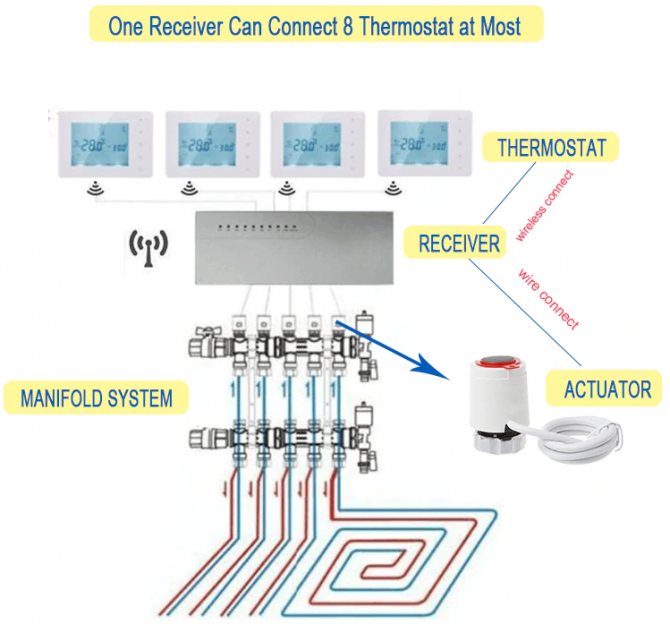

Twin models: the same device, but unnamed in the Side-To-Side store and TWC-08 for 1700r, but without reviews and orders.
Passport on Yandex disk CCT-10 Hub Controller.pdf.
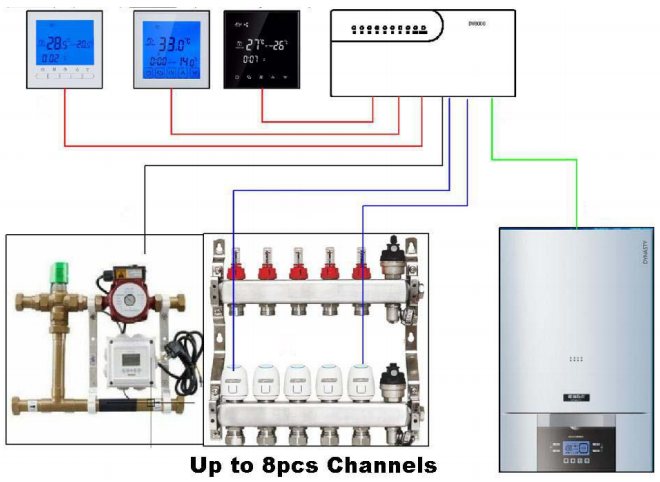

Let's study the connection diagrams in the passport.
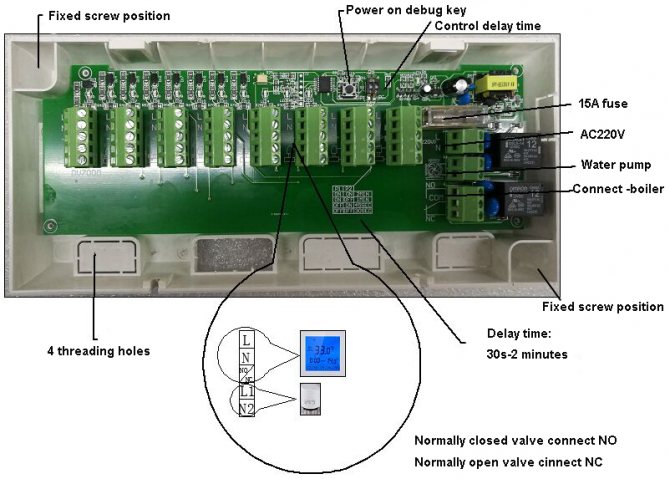

It is not entirely clear whether it is suitable for thermostats that issue 220V. But the price - cheaper than doing it yourself - encourages experimentation.
Saswell SCU209 underfloor heating control center.
SCU209 on the manufacturer's website.
SCU209 on AliExpress.


The radio version for 5 zones costs 4700r.
The wired option should cost 3600 rub (at Amazon 44 euros).
Unfortunately, now on AliExpress, there is only an option with connecting room thermostats via radio.
Uponor Base X25.
Uponor's modular radiant heating control systems are noteworthy - they are one of the options for the ideal underfloor heating control system.
Let's take a look at the simplest Uponor Base X25 wired controller with pump relay.
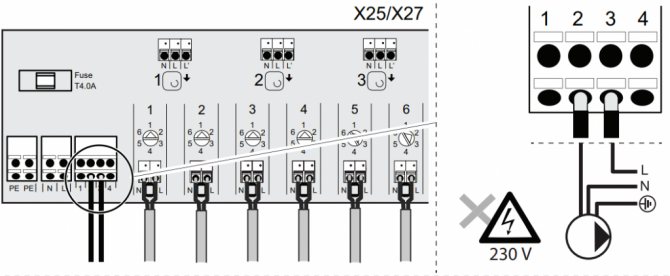

This device is worth more than 9400r.
Functionality:
- Rotary channel selector for convenient registration of actuators;
- Pump relay 2A;
- Overload protection;
- Power LED;
- 6 channels (thermostats);
- 12 actuators.
Uponor Base X25 passport in pdf: installation-manual-uponor-base-4.pdf.
Expensive, but the Uponor product line is worth exploring.
The principle of operation of a mixer with a two-way valve
The thermal head with a sensor for underfloor heating is connected to a system with a two-way valve. Through it, hot water is supplied from the boiler to the mixing unit.
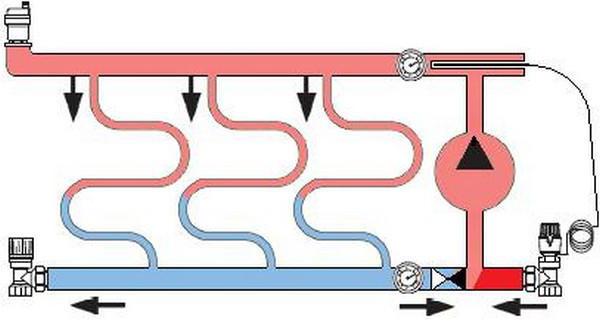

The sensor detects the temperature of the heating medium supplied to the floor heating, and when it is high, the thermal head valve cuts off the supply from the boiler. The circulation will take place along the internal circuit until the water begins to cool down.When the set minimum value of the coolant temperature is reached, a command is sent from the sensor to supply hot water and it again begins to mix with return.
The small throughput of the two-way valves provides heating of rooms with an area of no more than 200 m2.
Valtec VT.ZC.
Junction box Valtec VT.ZC for 8 channels 220V costs 6000r.


Wasn't it possible to come up with something interesting? Or do they think that they have stuck it on "Made in Russia" and eat it?
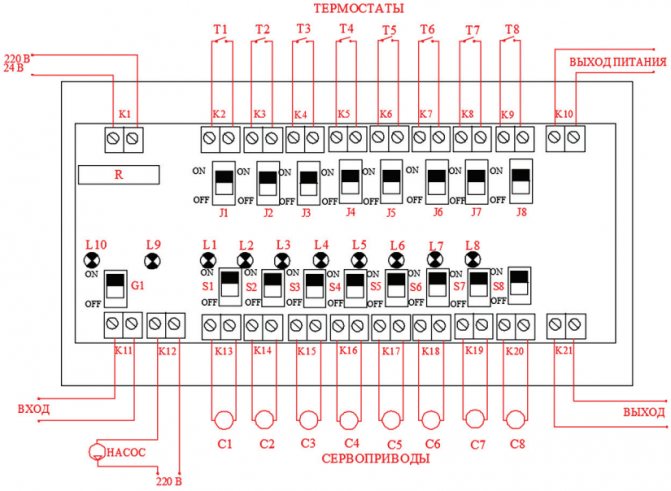

Passport in pdf.
A study of the passport showed that this controller has all sorts of different switches that allow you to group outputs and set up cascade control. Perhaps the presence of switches and influenced the price.
1500r price for him. And he only needs thermostats with contacts.
Controller for controlling servo drives of heating radiators SMART CHR-08.
It costs 7950r.
For some reason, there is no such controller for 220V in the equipment line. Therefore, consider the SMART CHR-08 controller, which controls 24V servos.


It is unclear why this device is needed for that kind of money, because it is essentially a terminal block with light bulbs.
External thermal head for warm floor
In an underfloor heating system with automatic control, the room temperature is monitored by thermostats associated with the controller. The remote room thermostat sends a signal to the servo drive, which controls the manifold valve. In addition, the controller has the following functions:
- response to sensor readings, including outside the house;
- organization of heating modes for certain rooms;
- turning off and turning on heating in individual rooms at different times;
- work with remote control via GSM communication.
The cost of automation will pay off over time, since it allows you to save up to 20% of the money spent on heating.
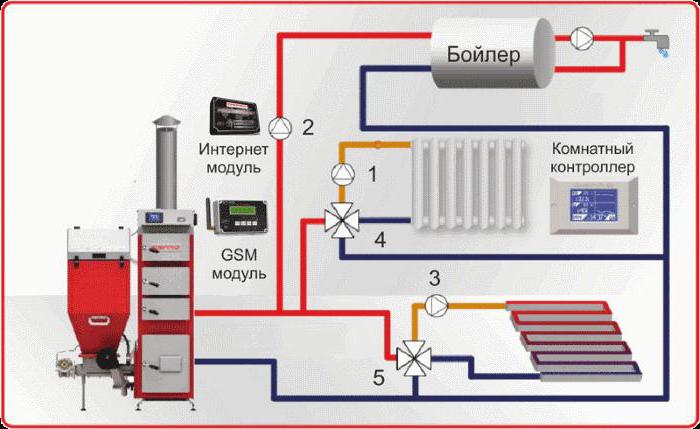

Insolo.
Zone Communicator Insolo Pro Aqua costs 14135r.


Passport in pdf.
This device is clearly more than a terminal box. The communicator can regulate the temperature of the underfloor heating supply heating medium, depending on the outside air temperature, as well as control and exclude its overheating above 55 ° C, by adjusting the mixing valve servo using an additional outside air temperature sensor.
The communicator has relay outputs to control the operation of the boiler and the circulation pump.
Mode of night lowering of the coolant temperature. Protection against lack of coolant.
LCD display showing the status of inputs and outputs. Programming from the communicator panel.
There is a model without a display and buttons, but with Wi-Fi.
In principle, a level has been set to which manufacturers of such devices should strive.
Equipment characteristics
The coolant from the boiler passes through the pipe line to the collector. From it, the liquid enters the floor pipeline. Giving off heat, it returns back to the collector, which has a separate return outlet for the cooled heat carrier. The circulation pump pumps water back into the boiler.
With manual control of the temperature regime, valves are installed on the circuit with cold water and a heat carrier of high temperature. If the room has warmed up well enough, then the hot water valve is closed. If the room is cold, then the valve is opened.
For automatic regulation of the heating mode, a three-way mixer with a thermostat and an external temperature sensor is installed. This system forms a thermostatic valve. It is installed at the inlet to the manifold. The equipment is made of brass or bronze.
- The three-way valve has 3 outlets for hot and cold water and for the heating medium, which is supplied to the floor line. On the case, markers indicate the direction of flows of different temperatures.
- A mixing chamber is provided for mixing liquids of different temperatures.
- A thermostat with a temperature controller is located on the body.
- The temperature sensor is located on the thermostat.
- The valves close off the cold and hot flow outlets. They can be disc-shaped or needle-shaped. Their work depends on the thermostat.
- The thermostat is a system that consists of a liquid capsule and a spring-loaded stem. Valves are attached to it.
- The temperature sensor has a digital panel on which the heating modes are indicated.
We recommend: How to make a dry warm floor?
The thermostat can be located in the thermal head or in the actuator. The devices have a different circuit, but the same principle of operation. The thermal head is a thermostat, which works with the help of a liquid: it is sensitive to temperature changes.
The servos are powered by the electrical network. The liquid is contained in a container. It contains a heating plate. The servo is installed on the manifold.


The three-way mixer is designed for heating systems of large areas. In separate rooms or in country houses, a two-way valve is connected to the collector. It is installed on a circuit with a high temperature coolant. Water flows through it in only one direction.
Relay logic.
Simple relay logic is fine with my thermostats. You can assemble the heating controller yourself, especially since it will be very simple.
For five directions, 6 relays are needed.
The coils of the 5 relays will be connected in parallel with the valve actuators. Their closing contacts will be connected in parallel to turn on the pump of the mixing unit, if at least one direction is switched on.
The sixth relay will control the boiler and is designed to remove high voltage from the contact group. The coil of this relay will be connected in parallel with the pump of the mixing unit.
The result will be a control system with additional outputs - there are several groups of contacts for the relay. You can use these contacts to build a remote monitoring system and collect statistics.
The cheapest relay with a socket will cost 200 rub.
AliExpress.com Product - Free shipping HH54P MY4NJ plug-in relay PYF14A 12v 24v 36v 48v 110v 220v DC / AC 5A silver contact 14pins 4PDT rele socket
Plus a box with a din rail 200 rub.
Total: 6 * 200 + 200 = 1400 rubles.
Well, what else is needed?


